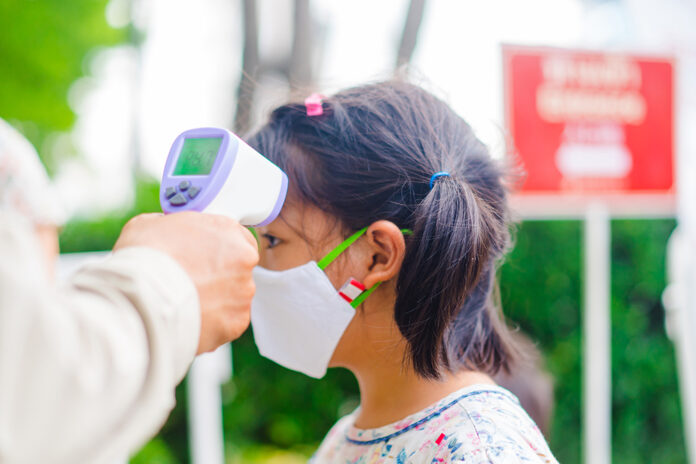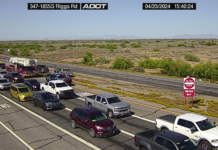
Getting children back on school campuses is less fun than it sounds.[pull_quote_right]Self-regulation and stress-management are going to be really, really important this year.[/pull_quote_right]
The opening of the 2020-21 year looms for Maricopa Unified School District and charter schools, with most starting entirely online. With an unknown date for returning to in-person education, school leaders looked for a balance between best health practices and the wishes of families before presenting a plan to roll out the return. Another component is preparing students psychologically for a new experience.
As the Arizona Department of Education presented a “Roadmap for Reopening Schools,” it told schools that implementing direction from the Centers for Disease Control and Prevention “should be guided by what is feasible, practical, acceptable and tailored to the needs of each community.”
Gov. Doug Ducey’s executive order keeps kids off campus until at least Aug. 17, and Arizona School Board members are pushing for a delay in the return to physical classrooms until October. MUSD board member Torri Anderson said she would like to keep children learning remotely until fall break, which is Oct. 5.
Heritage Academy has a July 22 all-online start date. MUSD starts July 30 online. A+ Charter Schools, which is debuting this year, starts Aug. 3 online. Sequoia Pathway will start Aug. 4. Legacy Traditional School starts Aug. 5 and is hosting a July 15 virtual town hall to explain the plan. Leading Edge plans to start school Aug. 17 in person but with an online option for families that prefer to stay at a distance.
MUSD surveyed parents to learn if and how families wanted children to return to campus. Some shared their ideas and concerns about reopening with InMaricopa, as well.
“Open the schools as normal, but with extra sanitation precautions,” Jesselee Evans Green said. “At my work, we stop every two hours to clean every surface that’s been touched. It only takes a couple of minutes. Kids can help with that by wiping their desks down at the end of the class. Extra hand washing stations around the schools as well …. My kids need to go back to a learning environment that they enjoy.”
HEALTH
District Nurse Lizabeth Stephens, R.N., created an infection-control plan for MUSD that is ready to go when the day comes. She and the Health Services Department will put together health tubs for each teacher.
“It contains some backup hand sanitizer and also some Lysol spray, the larger alcohol wipes that are also with virucide. I read the label; it works perfectly. And with gloves and masks,” Stephens said.
School nurses will also create a video for teachers about the items in their infection-control tub, explaining how and when to use them. Stephens said she does not want teachers to use certain items incorrectly.
They will explain the difference between disinfecting and cleaning, for example.
“I’m also going to put together a video for the kids on the first day about the importance of social distancing, keeping as far apart as possible under the circumstances,” she said. “Coughing and how important it is to keep their hands clean.”
To convey the basics to students of all ages, they will explain the concept of sterile technique, “Clean to clean; dirty to dirty.” That means if something is dirty and you touch it with your hand, your hand is now dirty and needs to be cleaned.
At Leading Edge, all students and staff will be temperature checked upon entry to school each day. Masks may be worn but are not mandatory. All classrooms will have hand sanitizer. Cleaning and disinfecting procedures will be intensified, and there will be training in health and safety protocols.
MUSD schools will establish entry points where health workers will take the temperature of each student that comes in. It’s not a diagnosis but it is a screening. Students who have a temperature of 100 or more are sent to the health office. Students with a temperature of 100.4 are sent home.
Students are expected to go to their classrooms immediately rather than milling in the hall and mixing with large groups before the first bell.
“We’re trying to cohort the classrooms as the group, however many kids there may be,” Stephens said.
For the elementary grades, that means, where feasible, schools will try to have art in their classroom and music in the classroom. They may even have breakfast and lunch in the classroom.
Principals and teachers will plan the recess times, which may not allow use of playground equipment. A cohort may be assigned a specific section of the play area for physical activity. And hand sanitizer will always be nearby.
But they are still dealing with very young children.
“All we can do is the best we can,” Stephens said. “We try to teach them to be safe. As long as they’re not hugging each other and slobbering all over each other, I don’t care if they hold hands.”
Health Services has had video meetings with custodial staff to go through the cleaning and disinfecting process. If more than one cohort uses a classroom, the room will be disinfected between each cohort. If only one cohort uses the room, it will be disinfected once or twice a week.
For all ages, the nurses are encouraging masks on the bus or from their drop-off point onto school grounds. If parents want their children to wear a mask in more settings, that can be accomplished up to a point.
“Children should not sit in a mask all day long in a room,” Stephens said. “It’s the rebreathing of the carbon monoxide. It’s not safe for anyone to wear a mask all day long.”
She said teachers would not wear masks while teaching unless they approach students to help with something. Afterward, both teacher and student are asked to clean their hands.
Middle school and high school, however, leaves Stephens at a loss, even with her many years of infection control. She has students wearing masks when they change classes. The schools may mark hallways to divide traffic moving in separate directions so students are not face to face.
To prevent congestion in the hallway, there may be monitors to move students along instead of stopping to chat. As they enter the classroom, they will be asked to clean their hands with school-provided hand sanitizer.
Meetings between Health Services and the principals were organized to get everyone’s ideas about how to put best health advice into practice. The Arizona Interscholastic Association’s COVID-19 guidelines are also a point of conversation.
There are procedures in place if a child who has been to school tests positive for COVID-19, especially determining who else has been exposed.
MENTAL HEALTH
“Overwhelmingly, what I’m hearing is students just want to go back to school,” said Amber Liermann, Exceptional Student Services behavioral counselor and licensed professional counselor and clinical supervisor.
Many parents, too, want their kids in the classroom.
The counseling department at MUSD has had weekly meetings during the fourth quarter of last school year and all through the summer to prepare for a start to a new school year unlike any other.
“We want to make sure that we’re staying on top of the developments of what’s going on and making sure that we are prepared to support our students and our families for whatever happens and whatever options are offered,” Liermann said.
They have discussed validating each family’s and each student’s personal experience with COVID-19. Some families might have lost a loved one. Some might have financial impact while others were not as affected.
They will be coming back with different levels of socialization as well. When students do come back, reestablishing attachments, from elementary to high school students, has vital importance.
“It’s important to create routines as normal as possible so the students regain security,” Liermann said. “We would replace old rituals with new rituals. At the elementary schools, in particular, students want that hug from teachers. So, instead of a hug or a high five, they’ll have a tingle and a dance.”
The campuses have Positive Behavior Interventions & Support (PBIS) teams to help students make good decisions if they are feeling stressed. All schools also have Comfort Corners but will change how they are used to avoid sharing tools.
The teletherapy and video chats available last quarter will continue when appropriate.
“Self-regulation and stress-management are going to be really, really important this year,” Liermann said. “There are going to be fears and anxiety coming from students going to school. We will be teaching stress-management tools, help teachers know when to give breaks.”
Health Services asked to participate in administration training to talk about trauma informed care, crisis prevention and de-escalation strategies for a most unusual beginning of a new school year.
This story appears in part in the July issue of InMaricopa.





![Maricopa’s ‘TikTok Rizz Party,’ explained One of several flyers for a "TikTok rizz party" is taped to a door in the Maricopa Business Center along Honeycutt Road on April 23, 2024. [Monica D. Spencer]](https://www.inmaricopa.com/wp-content/uploads/2024/04/spencer-042324-tiktok-rizz-party-flyer-web-218x150.jpg)







![Alleged car thief released without charges Phoenix police stop a stolen vehicle on April 20, 2024. [Facebook]](https://www.inmaricopa.com/wp-content/uploads/2024/04/IMG_5040-218x150.jpg)



